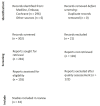Photodynamic Therapy for Field Cancerization in the Skin: Where Do We Stand?
- PMID: 37992384
- PMCID: PMC10656191
- DOI: 10.5826/dpc.1304a291
Photodynamic Therapy for Field Cancerization in the Skin: Where Do We Stand?
Abstract
Introduction: Photodynamic therapy (PDT) with a photosensitizer is available for the treatment of multiple actinic keratoses (AKs) in a restricted skin area or, as it is established, for the field-cancerized skin.
Objectives: Our review aims to present the up-to-date literature on skin field cancerization using PDT employing different topical photosensitizers, modified light delivery protocols and combination treatments to obtain excellent efficacy and safety in everyday clinical practice.
Methods: We sought PubMed, MEDLINE, Scopus, OVID, Embase, Science Direct, Cochrane Library, Research Gate and Google Scholar for [(aminolevulinic acid OR aminolevulinate) AND photodynamic therapy] with (field-directed OR field cancerization, (actinic keratosis), and (efficacy OR effectiveness OR pain OR tolerability) for studies published until February 2023.
Results: Advantages of PDT compared to the other field treatments, including imiquimod, 5-fluorouracil, ingenol mebutate gel and diclofenac, reported better cosmetic outcomes and greater patient satisfaction. On the other hand, some drawbacks of field PDT include pain and treatment duration. Alternate illumination methods have also been investigated, including daylight as a light source. Pretreating the affected area may enhance photosensitizer absorption leading to better therapeutic results, while combinational treatments have also been tested. Patients prefer daylight PDT to traditional light sources since it is more well-tolerated and equally effective. Even as a preventive treatment, field PDT yields promising outcomes, especially for high-risk individuals, including organ transplant recipients.
Conclusions: This review provides a thorough display of the field of PDT on cancerized skin, which will facilitate physicians in applying PDT more efficiently and intuitively.
Conflict of interest statement
Figures
References
-
- Morton CA, Szeimies RM, Basset-Séguin N, et al. European Dermatology Forum guidelines on topical photodynamic therapy 2019 Part 2: emerging indications - field cancerization, photo-rejuvenation and inflammatory/infective dermatoses. J Eur Acad Dermatol Venereol. 2020;34(1):17–29. doi: 10.1111/jdv.16044. - DOI - PubMed
Publication types
LinkOut - more resources
Full Text Sources


